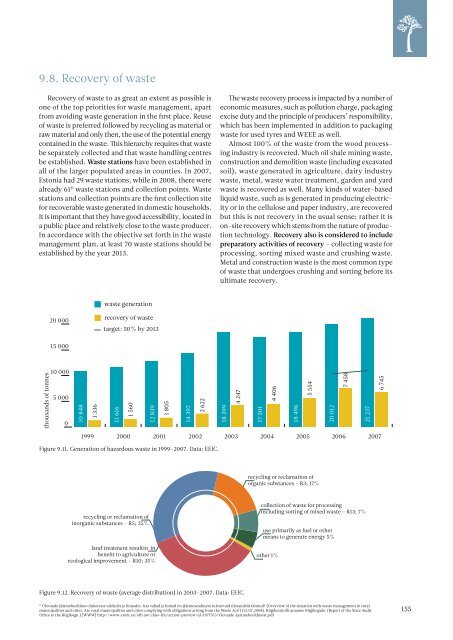ESTONIAN ENVIRONMENTAL REVIEW 2009
ESTONIAN ENVIRONMENTAL REVIEW 2009
ESTONIAN ENVIRONMENTAL REVIEW 2009
Create successful ePaper yourself
Turn your PDF publications into a flip-book with our unique Google optimized e-Paper software.
9.8. Recovery of waste<br />
Recovery of waste to as great an extent as possible is<br />
one of the top priorities for waste management, apart<br />
from avoiding waste generation in the first place. Reuse<br />
of waste is preferred followed by recycling as material or<br />
raw material and only then, the use of the potential energy<br />
contained in the waste. This hierarchy requires that waste<br />
be separately collected and that waste handling centres<br />
be established. Waste stations have been established in<br />
all of the larger populated areas in counties. In 2007,<br />
Estonia had 29 waste stations, while in 2008, there were<br />
already 61 D waste stations and collection points. Waste<br />
stations and collection points are the first collection site<br />
for recoverable waste generated in domestic households.<br />
It is important that they have good accessibility, located in<br />
a public place and relatively close to the waste producer.<br />
In accordance with the objective set forth in the waste<br />
management plan, at least 70 waste stations should be<br />
established by the year 2013.<br />
waste generation<br />
The waste recovery process is impacted by a number of<br />
economic measures, such as pollution charge, packaging<br />
excise duty and the principle of producers’ responsibility,<br />
which has been implemented in addition to packaging<br />
waste for used tyres and WEEE as well.<br />
Almost 100% of the waste from the wood processing<br />
industry is recovered. Much oil shale mining waste,<br />
construction and demolition waste (including excavated<br />
soil), waste generated in agriculture, dairy industry<br />
waste, metal, waste water treatment, garden and yard<br />
waste is recovered as well. Many kinds of water-based<br />
liquid waste, such as is generated in producing electricity<br />
or in the cellulose and paper industry, are recovered<br />
but this is not recovery in the usual sense; rather it is<br />
on-site recovery which stems from the nature of production<br />
technology. Recovery also is considered to include<br />
preparatory activities of recovery – collecting waste for<br />
processing, sorting mixed waste and crushing waste.<br />
Metal and construction waste is the most common type<br />
of waste that undergoes crushing and sorting before its<br />
ultimate recovery.<br />
25000.000000<br />
25 000<br />
20 000<br />
15 000<br />
recovery of waste<br />
target: 50% by 2013<br />
16666.666667<br />
thousands of tonnes<br />
10 000<br />
5 000<br />
0<br />
10 848<br />
1 336<br />
11 616<br />
1 560<br />
12 839<br />
1 805<br />
14 397<br />
2 622<br />
18 399<br />
4 247<br />
17 501<br />
4 406<br />
18 496<br />
5 554<br />
20 012<br />
7 458<br />
21 237<br />
6 745<br />
8333.333333<br />
0.000000<br />
1999<br />
2000<br />
2001 2002 2003 2004<br />
2005 2006<br />
2007<br />
Figure 9.11. Generation of hazardous waste in 1999–2007. Data: EEIC.<br />
recycling or reclamation of<br />
organic substances – R3; 17%<br />
recycling or reclamation of<br />
inorganic substances – R5; 35%<br />
land treatment resultin in<br />
benefit to agriculture or<br />
ecological improvement – R10; 35%<br />
collection of waste for processing<br />
including sorting of mixed waste – R13; 7%<br />
use primarily as fuel or other<br />
means to generate energy 5%<br />
other 1%<br />
Figure 9.12. Recovery of waste (average distribution) in 2003–2007. Data: EEIC.<br />
D<br />
Ülevaade jäätmehoolduse olukorrast valdades ja linnades. Kas vallad ja linnad on jäätmeseadusest tulenevaid ülesandeid täitnud? (Overview of the situation with waste management in rural<br />
municipalities and cities. Are rural municipalities and cities complying with obligations arising from the Waste Act?) (22.07.2008). Riigikontrolli aruanne Riigikogule. (Report of the State Audit<br />
Office to the Riigikogu.) [WWW] http://www.envir.ee/orb.aw/class=file/action=preview/id=1077573/Ylevaade+jaatmehooldusest.pdf<br />
155

















